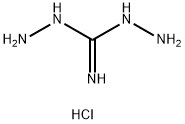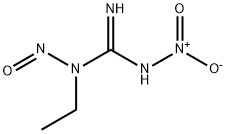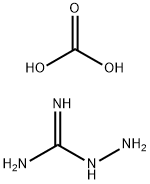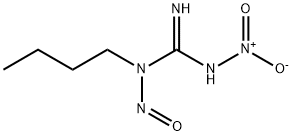pimagedine
- CAS NO.:79-17-4
- Empirical Formula: CH6N4
- Molecular Weight: 74.09
- MDL number: MFCD00242587
- EINECS: 2011831
- SAFETY DATA SHEET (SDS)
- Update Date: 2023-10-19 15:30:33

What is pimagedine?
Chemical properties
Aminoguanidine [CAS: 79-17-4], CH6N4, Mr 74.09, is a base that forms salts with both inorganic and organic acids. It is soluble in water and ethanol. Free aminoguanidine is stable for only a short time; therefore, it is marketed in the form of its stable salts. Commercially, aminoguanidine is offered as the bicarbonate salt [2582-30-1], a white powder of usually 99 % assay. The water solubility at room temperature is low (< 5 g/L). It is offered by most world-scale hydrazine producers (→Hydrazine). Other salts can be prepared from the bicarbonate by reaction with acid.
Chemical properties
Aminoguanidine is prepared from hydrazine
and aqueous cyanamide solution. Processes
based on the reduction of nitroguanidine have
no industrial significance.
The Uses of pimagedine
Inhibitor (advanced glycosylation end-product formation).
Definition
ChEBI: Aminoguanidine is a one-carbon compound whose unique structure renders it capable of acting as a derivative of hydrazine, guanidine or formamide. It has a role as an EC 1.4.3.4 (monoamine oxidase) inhibitor and an EC 1.14.13.39 (nitric oxide synthase) inhibitor. It is a member of guanidines and a one-carbon compound.
Enzyme inhibitor
This substituted hydrazine (FWhydrochloride = 110.55 g/mol; CAS 79-17-4), also named pimagedine, is a strong inhibitor of diamine oxidases as well as nitric oxide synthase. Note that aminoguanidine also inhibits the formation of advanced glycosylation end-products, reportedly by reacting with and trapping Amadori rearrangement-derived fragmentation products in solution. In view of this property, aminoguanidine has often been used to treat complications associated with chronic diabetes. Target(s): amine oxidase (copper-containing), or diamine oxidase; methylamine dehydrogenase; tryptophan tryptophylquinone enzymes; nitric-oxide synthase; b-fructofuranosidase, or invertase; monoamine oxidase, or amine oxidase; histidine decarboxylase; aldose reductase; catalase; formation of advanced glycosylation end products; adenosylmethionine decarboxylase; arginine deaminase; arginine kinase; aspartate aminotransferase; histamine N-methyltransferase.
Properties of pimagedine
| Melting point: | 182-185 °C (decomp) |
| Boiling point: | 159.5±23.0 °C(Predicted) |
| Density | 1.72±0.1 g/cm3(Predicted) |
| refractive index | 1.6660 (estimate) |
| pka | 11.08±0.70(Predicted) |
Safety information for pimagedine
Computed Descriptors for pimagedine
New Products
Tert-butyl bis(2-chloroethyl)carbamate (S)-3-Aminobutanenitrile hydrochloride N-Boc-D-alaninol N-BOC-D/L-ALANINOL 3-Morpholino-1-(4-nitrophenyl)-5,6-dihydropyridin- 2(1H)-one N-octanoyl benzotriazole 3,4-Dibenzyloxybenzaldehyde 1,1’-CARBONYLDIIMIDAZOLE R-2-BENZYLOXY PROPIONIC ACID 1,1’-CARBONYLDI (1,2-4 TRIAZOLE) 4-HYDROXY BENZYL ALCOHOL 3-NITRO-2-METHYL ANILINE (2-Hydroxyphenyl)acetonitrile 4-Bromopyrazole 5-BROMO-2CYANO PYRIDINE 5,6-Dimethoxyindanone 5-broMo-2-chloro-N-cyclopentylpyriMidin-4-aMine 2-(Cyanocyclohexyl)acetic acid 4-methoxy-3,5-dinitropyridine 2-aminopropyl benzoate hydrochloride 1-(4-(aminomethyl)benzyl)urea hydrochloride tert-butyl 4- (ureidomethyl)benzylcarbamate diethyl 2-(2-((tertbutoxycarbonyl)amino) ethyl)malonate Ethyl-2-chloro((4-methoxyphenyl)hydrazono)acetateRelated products of tetrahydrofuran








You may like
-
 N-Vinylformamide 99%View Details
N-Vinylformamide 99%View Details
13162-05-5 -
 Chloro Uracil 1820-81-1 99%View Details
Chloro Uracil 1820-81-1 99%View Details
1820-81-1 -
 2-ethyl-6-methyl-3-hydroxypyridine succinate 99%View Details
2-ethyl-6-methyl-3-hydroxypyridine succinate 99%View Details
127464-43-1 -
 2-ETHYLPYRIDINE 100-71-0 99%View Details
2-ETHYLPYRIDINE 100-71-0 99%View Details
100-71-0 -
 7439-89-6 Electrolytic Iron Flakes 99.9% MaxView Details
7439-89-6 Electrolytic Iron Flakes 99.9% MaxView Details
7439-89-6 -
 7439-89-6 98.0% MinView Details
7439-89-6 98.0% MinView Details
7439-89-6 -
 Reduced Iron Powder 99.8% MaxView Details
Reduced Iron Powder 99.8% MaxView Details
7439-89-6 -
 Electrolytic Iron Powder 7439-89-6 99.8% MaxView Details
Electrolytic Iron Powder 7439-89-6 99.8% MaxView Details
7439-89-6